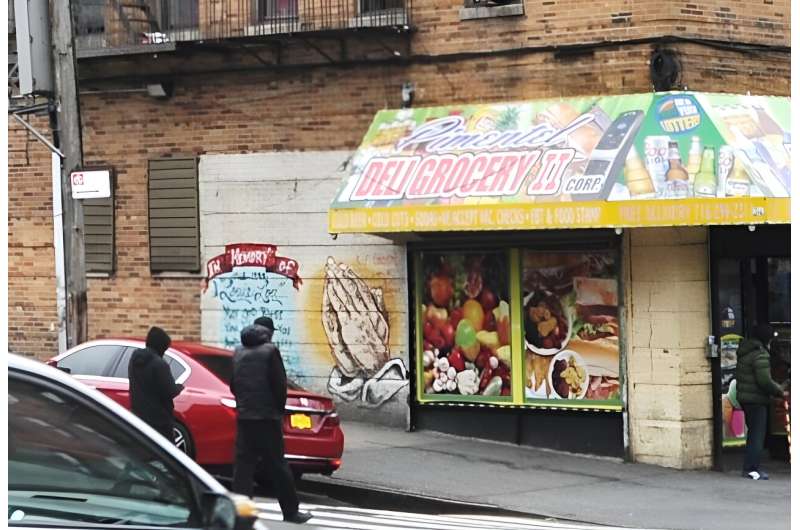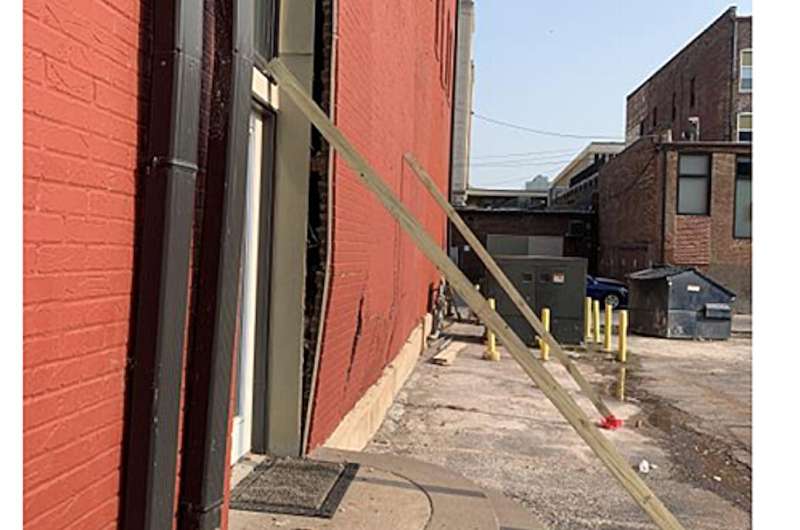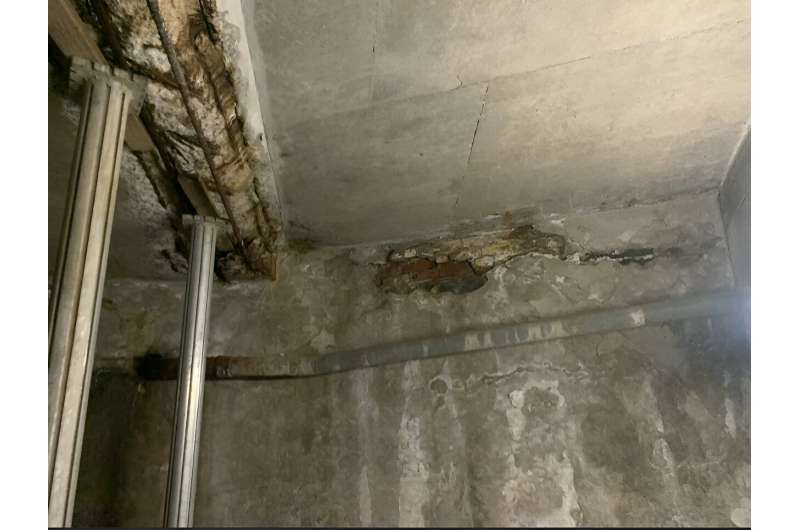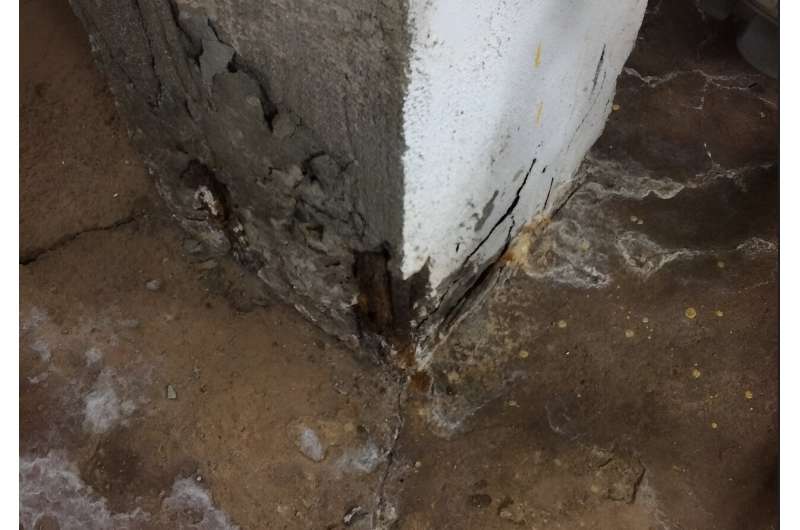This article has been reviewed according to Science X's editorial process and policies. Editors have highlighted the following attributes while ensuring the content's credibility:
fact-checked
trusted source
written by researcher(s)
proofread
How to prevent America's aging buildings from collapsing: Four high-profile disasters send a warning

Four recent catastrophic building collapses and a near miss are raising concerns about the state of America's aging buildings and questions about who, if anyone, is checking their safety.
Many cities have buildings showing signs of aging and in need of repair. In New York City, where a seven-story apartment building partially collapsed in December 2023, the median building age is about 90 years, and many neighborhoods were built before 1900.
As a civil engineer, I study building failures, and I have seen how crucial structural inspections and careful maintenance are—and how often the signs of trouble are ignored in the U.S. until a problem becomes a crisis. Too often, it is up to residents to call attention to the risks.
Many disasters had clear warning signs
There were two common threads prior to many of the recent building collapses: visible signs of the defects that eventually led to the building's demise and a history of documents submitted to city building departments clearly showing deteriorating conditions.
For example:
- In June 2021, the sudden collapse of the Champlain Towers South condominium in Surfside, Florida, killed 98 people and stunned the nation. Three years earlier, an engineers report had raised concerns about the structural integrity of concrete in the pool deck area that later collapsed, but the strength of the pool deck slab was not thoroughly investigated. Federal investigators in a 2023 preliminary report found that the original design of the pool deck did not follow building standards.
- In May 2023, three people died when part of a 116-year-old apartment building in Davenport, Iowa, collapsed. Inspectors pointed to a history of improper maintenance, and photos show clear signs of trouble, such as walls that were bowed.
- In April 2023, one person was killed when a New York City parking garage collapsed. The nearly-100-year-old building had several past violations, and its collapse triggered a swift check of similar garages that turned up more potential hazards.
In a near-miss, in November 2023, a large hole opened in the base of another New York City parking garage, offering a view to the Amtrak rail line below. It forced the closure of the line while the building was repaired.
What cities and states can do
Many buildings today are designed to last from as little as 50 years to over 100 years, depending on the materials used and assuming periodic maintenance and repairs.
Just as human beings need to see their physicians on a more regular basis as they age, older buildings also require more care and attention. That is even more important when they are exposed to adverse environmental conditions, such as corrosive de-icing salts in the Northeast and saltwater and salt air moisture in coastal regions.
Yet, inspections of buildings primarily happen only as they are being built, resold or remodeled. Policies vary by state, but there are currently few widespread mandated rules for structural inspections of entire existing buildings. Some exceptions are in Florida, where structural inspections are required for condominium and co-op buildings statewide at age 25 to 30 years, and every 10 years thereafter, and Jersey City, New Jersey, where periodic structural inspections are required every 10 years for all buildings. Several Florida cities and counties have extended the state-mandated periodic inspections to commercial buildings.
Some cities have enacted ordinances governing periodic inspections of specific structural elements, such as balconies and facades. And a few require periodic inspections or condition assessments for parking garages. After the Surfside condo tower collapse, the International Code Council initiated efforts to develop condition-assessment guidelines for existing buildings that local governments could choose to adopt.

Cities need to prioritize inspections
In each of the recent collapses, there were signs of the problems that, had they been addressed, might have prevented the tragedy.
In the New York City apartment building, a visible, vertical crack in the corner column, which should have been a glaring red flag, was ignored. The NYC Buildings Department commissioner recently said that "The Department of Buildings does not have enough of its own staff to inspect every building in New York City."
This problem is not unique to New York. Building departments across the country are understaffed and have oversight challenges.
If increasing budgets for municipal inspection departments is not an option, another route is to contract with structural engineering firms to review submitted documents. While this comes at a cost, so do legal settlements after building disasters.
If cities and states enact periodic structural condition assessment rules for existing buildings within their jurisdiction, problems could also be spotted by expert inspectors before they develop into failures.

Insurance companies could also be a partner in this effort by requiring periodic inspection and maintenance by licensed design professionals as a condition of continuing coverage.
If you see something, say something
Residents also must adopt a more vigilant and proactive approach to identify and prevent structural problems.
Anyone can learn to identify the telltale signs of building deterioration and defects, though there may be some hidden structural deterioration behind architectural finishes that may not be visible. If these problems are spotted and addressed in a timely manner, that could help reduce the likelihood of structural failures and more costly repairs in the future.

If you see any of the following problems, report them to your landlord or the city building department—they could be signs of structural trouble:
-
Water intrusion, ponding, leaks, water stains, rust stains and peeling paint on floors or ceilings.
- Sagging floors, roofs and ceilings and bulging or bowed walls.
- Cracks that are expanding in elevated floors or roof slabs, walls, beams and columns.
- Cracks on a floor slab that create a trip hazard, or wall cracks, which may be the result of the foundation settling.
- Chunks of concrete falling from slabs, beams, walls and columns; and exposed rusted steel reinforcement.
- Rusting or corroded steel beams and columns.
- Balconies where the rainwater drains toward the interior of the building, rather than away from it.
-
Rotted wood structural parts, such as floor joists or wall studs.
Everyone needs to understand the warning signs and be willing to speak up so officials and building owners take the necessary steps to stem this scary tide and protect residents.
Our buildings are talking to us, and in some cases crying out for help—it's time everyone listened.
This article is republished from The Conversation under a Creative Commons license. Read the original article.![]()



















